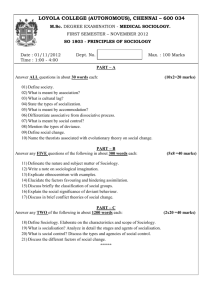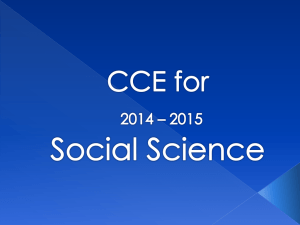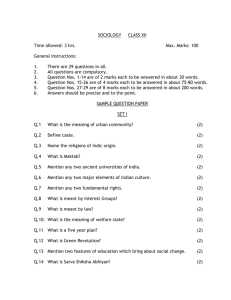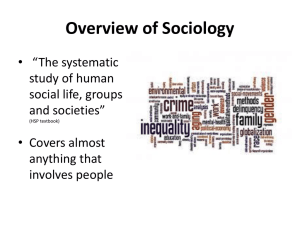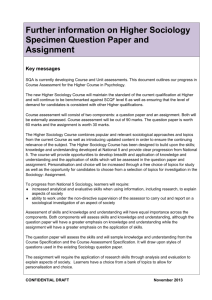SOCIOLOGY - IndiaStudyChannel.com
advertisement
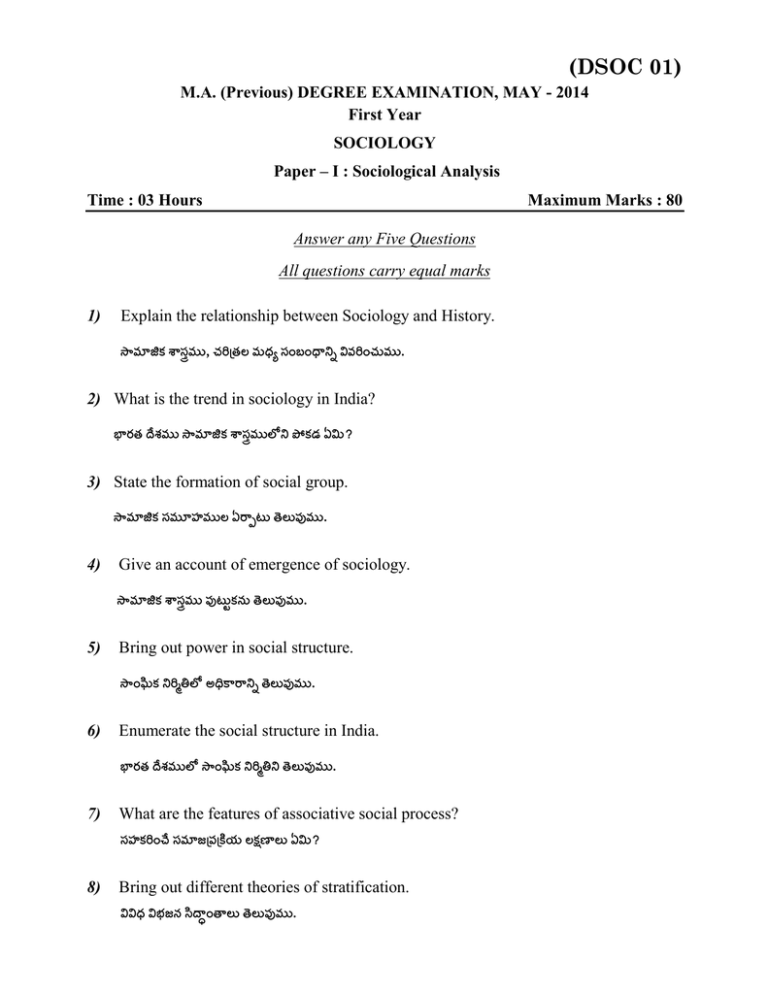
(DSOC 01)
M.A. (Previous) DEGREE EXAMINATION, MAY - 2014
First Year
SOCIOLOGY
Paper – I : Sociological Analysis
Time : 03 Hours
Maximum Marks : 80
Answer any Five Questions
All questions carry equal marks
1)
Explain the relationship between Sociology and History.
Õ È" .kPÞ ÌAßÔ‰È" #0 a ¿~” à È" (¤ Þ ½ ßÔ†²†¤ ¨ª ÉÈ" ¿†a (È" #2
2) What is the trend in sociology in India?
·%¾Þ'” ( Ì!*È" # Õ È" .kPÞ ÌAßÔ‰È" #Ä]¨ ¬.PÞ |Þ KÉ(B
3) State the formation of social group.
Õ È" .kPÞ ßÔÈ" $ß×*È" #Ã K¾A−u( ”6 Ã(ß«'È" #2
4)
Give an account of emergence of sociology.
Õ È" .kPÞ ÌAßÔ‰È" # ß«'u(wPÞ §" ( ”6 Ã(ß«'È" #2
5)
Bring out power in social structure.
Õ †;—(PÞ ¨¿»‡Ä] D¤¡PA¾A¨ª ”6 Ã(ß«'È" #2
6)
Enumerate the social structure in India.
·%¾Þ'” ( Ì!*È" #Ä] Õ †;—(PÞ ¨¿»‡¨ ”6 Ã(ß«'È" #2
7)
What are the features of associative social process?
ßÔß×*PÞ ¿†a( ßÔÈ" .i~ß«®PC ¼!*( Ã…Þ Ï%Ã( KÉ(B
8)
Bring out different theories of stratification.
Éɤ Þ É·!*i§" ;Ô ¦†” Ã( ”6 Ã(ß«'È" #2
9)
What are the factors that influence social change?
Õ †;—(PÞ È" .¾Þ'(−§" ( ~ß«·%É” È" # a( ¼!*# D†ÌAÃ( KÉ(B
10)
Critically examine any one theory of social change.
Õ †;—(PÞ È" .¾Þ'(−PÞ ( ßÔ†²†¤¡†b§" K ( ¨ ;Ô ¦†” ¨ª ÉÈ" (¾Þ'Ч ” »PÞ †YA ß«¿Îņa (È" #2
(DSOC 02)
M.A. (Previous) DEGREE EXAMINATION, MAY - 2014
First Year
SOCIOLOGY
Paper – II : Social Thought and Sociological Perspectives
Time : 03 Hours
Maximum Marks : 80
Answer any Five Questions
All questions carry equal marks
1)
Explain the origin of sociological theory.
Õ †;—(PÞ ÌAßÔ‰È" # ß«'u(wPÞ §" ( ÉÈ" ¿†a (È" #2
2) Bring out social statistics and dynamics.
Õ †;—(PÞ YÞ Ï%†PAÃ(0 YÞ È" (§ Ã( ”6 Ã(ß«'È" #2
3) Give an account of division of labour.
®ÌAÉ(PÞ É·!*i§" §" ( YÞ (¿†b ”6 Ã(ß«'È" #2
4)
State elementary forms of religious life.
È" (” ß«Q¿” lÉ” È" #Ä]¨ ~¬ œÞ É(PÞ ¾Þ'.¬ Ã( ”6 Ã(ß«'È" #2
5)
Critically examine the theory of class.
È" ¾Þ'\ ;Ô ¦†” ¨ª ÉÈ" (¾Þ'Ч ” »PÞ †YA ß«¿Îņa (È" #2
6)
Highlight the social change theory of Marx.
Marx ¼Q*#PÞ S Õ †;—(PÞ È" .¾Þ'(− ;Ô ¦†” È" #§" ( §SPC S a6 ß«•È" #2
7)
State the views of Weber on status and power.
ß×] 0 D¤¡PA¾Þ'È" # Ê( Þ È6 ²¾‹' EÄ]a §" ç" ( ”6 Ã(ß«'È" #2
8)
Review the contribution of Cooley and Mead.
Cooley and Mead à ”X| −u(§" ( ”6 Ã(ß«'È" #2
9)
Critically analyse the theory of social change.
Õ †;—(PÞ È" .¾Þ'(− ;Ô ¦†” ¨ª ÉÈ" (¾Þ'Ч ” »PÞ †YA ÉÌ(*Ç;цa (È" #2
10) State the thinking of Gandhi on Sarvodaya and non-violence.
ßÔ¾XË Þ ¼!*(0 D;×*†ßÔà Ê( Þ YA†¤¡ EÄ]a §" §" ( ”6 Ã(ß«'È" #2
(DSOC 03)
M.A. (Previous) DEGREE EXAMINATION, MAY - 2014
First Year
SOCIOLOGY
Paper – III : Social Research and Statistics
Time : 03 Hours
Maximum Marks : 80
Answer any Five Questions
All questions carry equal marks
1)
How do you formulate and test the hypothesis?
ß«¿PÞ Ã−§" §" ( Jv%Ç ¾Þ'.¬^†¡†b0 ß«À…Þ a( Õ ›È" 'B
2)
Explaining different kinds of probability sampling techniques.
Éɤ Þ ßÔ†·%È" ½” ~ß«‡a ¼!*(§" ¾Þ'PAÃ( ÉÈ" ¿†a (È" #2
3)
How do you prepare research design for a problem known to you?
Ê(PÞ ( ”6 Å;Ô§" ßÔÈ" (ßÔ½PÞ ( ß«¿Ì]¤ Þ §" ¾Þ'.ß«' ¾('TÃ( JÄ% ” ¼!*.¾Þ'( a( Õ ›È" 'B
4)
Enumerate different kinds of research designs.
Éɤ Þ ¾Þ'PAà ߫¿Ì]¤ Þ §" ¾Þ'.ß«PÞ Ã−§" Ã( ”6 Ã(ß«'È" #2
5)
What are the principles followed in classification and tabulation?
È" À\PÞ ¾Þ'Ï*0 ß«vC*wPb PÞ ¾Þ'Ï*Ä] ¬ vC*†a( ßÔ.~” Ã( KÉ(B
6)
Elucidate applications of correlation and regression in social science research.
Õ †;—(PÞ ÌAßÔ‰È" # Ì]¤ Þ §" Ä] ßÔß×* ßÔ†²†¤ Þ È" #0 ~ß«‡YÞ È" (§ à È" ¿›†ß«'Ã( ”6 Ã(ß«'È" #2
7)
State the steps involved in writing a research report.
ß«¿Ì]¤ Þ ¨È( ¡PÞ ” ¼!*.¾Þ'( a( ¼!*#uÄ]¨ D†a Ã( ”6 Ã(ß«'È" #2
8)
Enumerate the tools used in collecting data.
Þ ” ›†Ì!*È" # cÔPÞ ¿†a (uÄ] ɨ¼Q*.Z†a( Õ ¤ Þ § Ã( ”6 Ã(ß«'È" #2
9)
What are the merits and demerits of scientific method?
ÌAeÔ‰¼!*( ß« Þ ¦‡ ¼Q*#PÞ S YÞ (Ï*0 XÒ Ã( KÉ(B
10) Explain the forms of presentation of results.
ß—Å” ç" ( ¨È( ¡†a ( ¾Þ'.¬ Ã( ÉÈ" ¿†a (È" #2
(DSOC 04)
M.A. (Previous) DEGREE EXAMINATION, MAY - 2014
First Year
SOCIOLOGY
Paper – IV : Indian Society : Structure and Change
Time : 03 Hours
Maximum Marks : 80
Answer any Five Questions
All questions carry equal marks
1)
Explain different approaches to study Indian society.
·%¾Þ'” ( Ì!* ßԆߗ.¨ª D¤ Þ ½¼!*(§" È" # a( ¼!*# È" .¾A\Ã( ÉÈ" ¿†a (È" #2
2)
What are the features of Indian Caste System?
·%¾Þ'” ( Ì!* PÞ (à È" ½È" ßÔŸ Ã…Þ Ï%Ã( KÉ(B
3) State the legislation on Indian marriages.
·%¾Þ'” ( Ì!* ÉÈ ØÃPÞ ( ßÔ†²†¤¡†b ÌAßÔ§ ¨ª ”6 Ã(ß«'È" #2
4)
Explain any one theory relating to kinship.
²† Þ (” ˨PC ßÔ†²†¤¡†b K ( ¨ ;Ô ¦†” ¨ª ÉÈ" ¿†a (È" #2
5)
Bring out the emerging trend in inequality.
DßÔÈ" .§" ” ËÈ" #Ä] È" a( d ¬.PÞ |Þ §" ( ”6 Ã(ß«'È" #2
6)
Explain the changes in the Indian educational system.
·%¾Þ'” ( Ì!* É ½ È" ½È" ßÔŸÄ]¨ È" .¾Þ'(−ç" ( ÉÈ" ¿†a (È" #2
7)
Give an account of peasant movements in the recent past.
Fvb*È" Å PAÃÈ" #Ä] ¾R 6'” (ÃÄ] È" bd§" PÞ Þ ÅPÞ Ã§" ( ”6 Ã(ß«'È" #2
8)
Discuss the recent tensions in society.
ßÔ†ßß—(È" #Ä] Fvb*È" Å PAÃÈ" #Ä] K¾Þ'−|C §" M|C Þ (|Þ (PÞ (Ã( a ¿d†a (È" #2
9)
What is the impact of westernisation on Indian society?
·%¾Þ'” ( Ì!* ßÔÈ" .iÈ" # Ê( Þ ¬ ÌAd” ½ § YÞ ¿PÞ ~ß«·%È" È" # KÉ(B
10) Describe the nature and features of Indian family.
·%¾Þ'” ( Ì!* PÞ (u(†² ßÔ˾Þ'.ß«È" #0 Ã…Þ Ï%Ã( ÉÈ" ¿†a (È" #2
